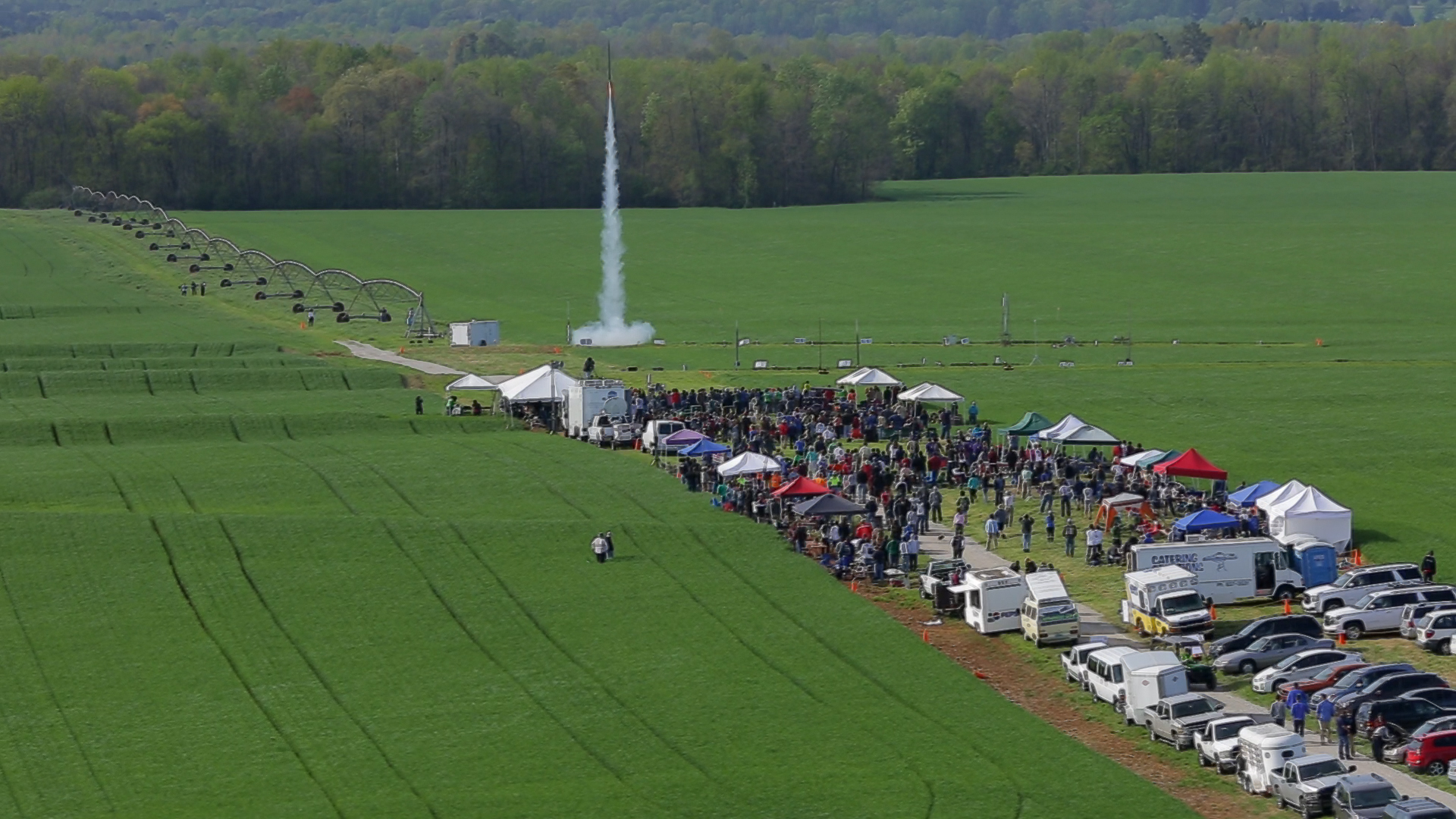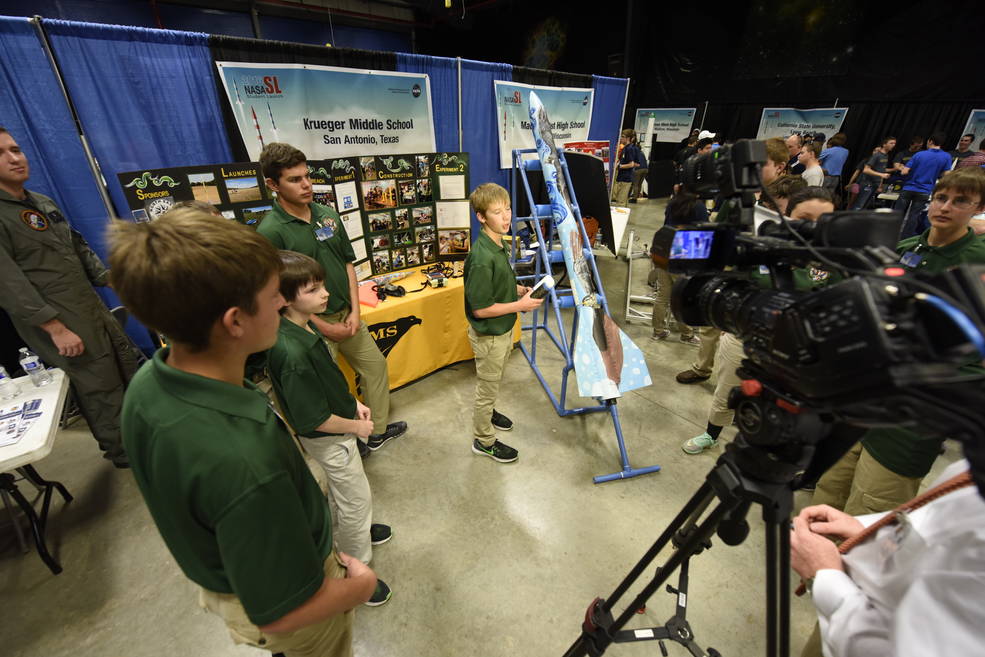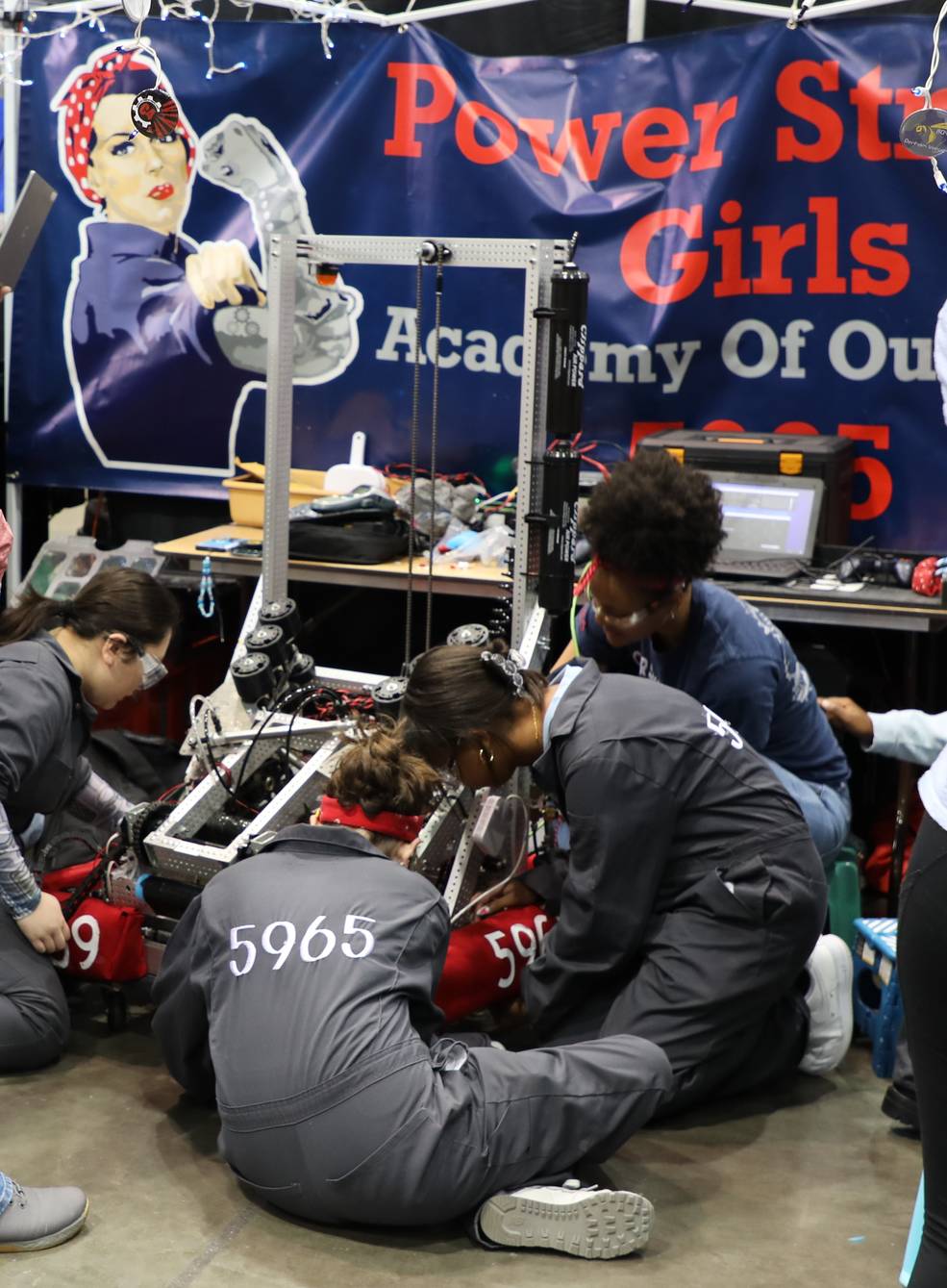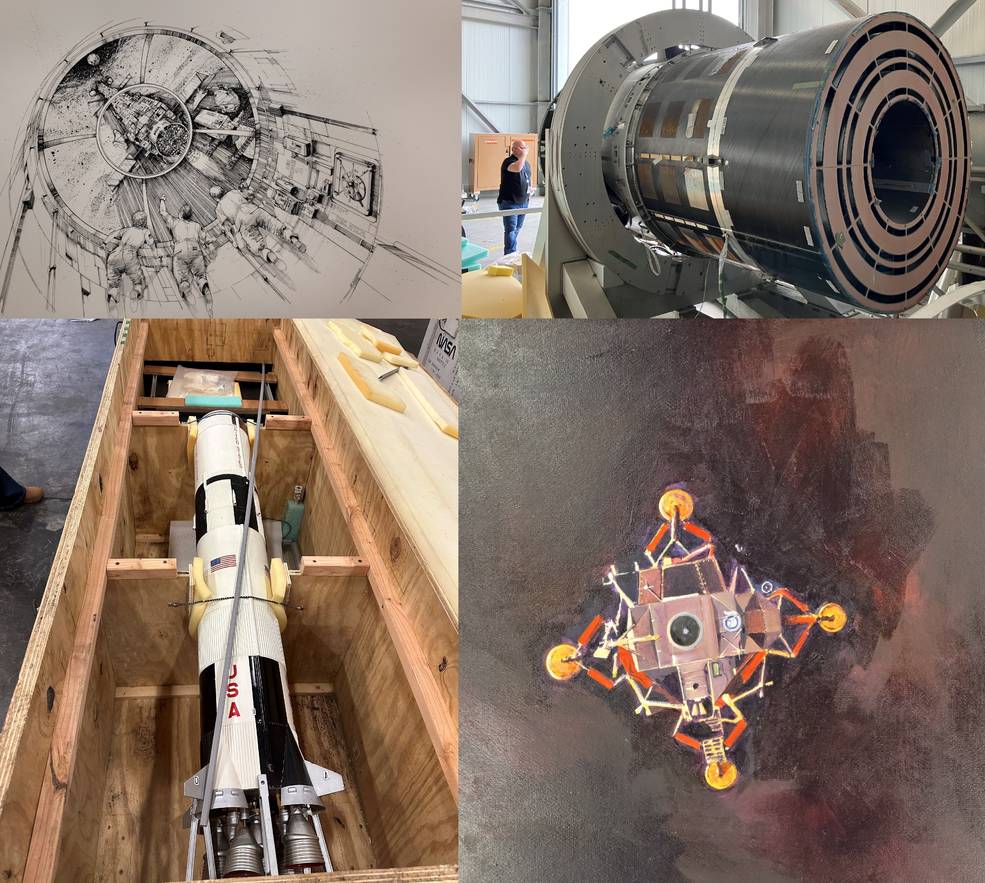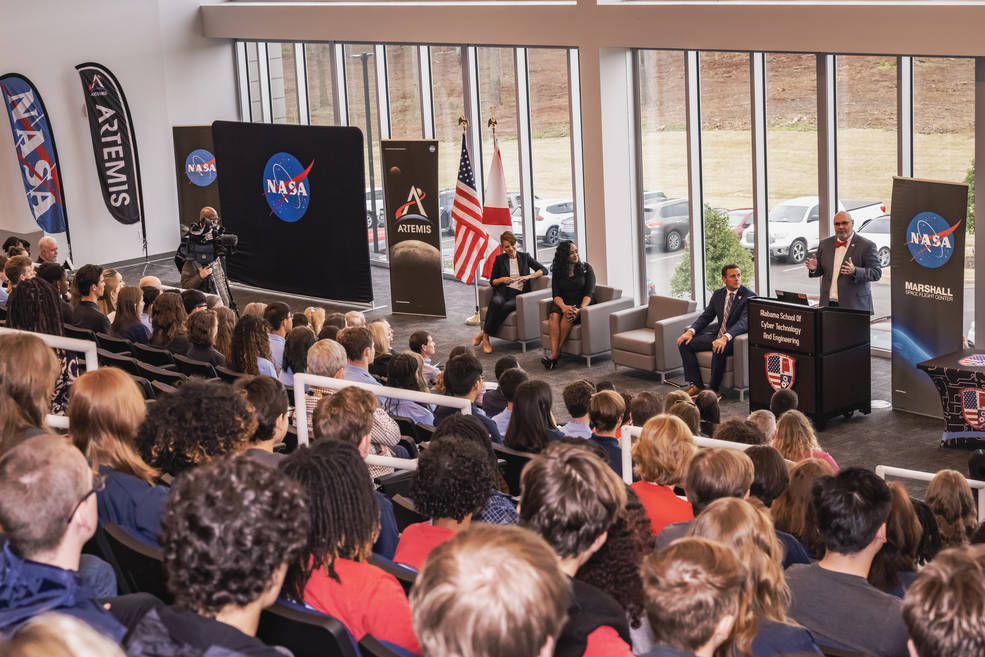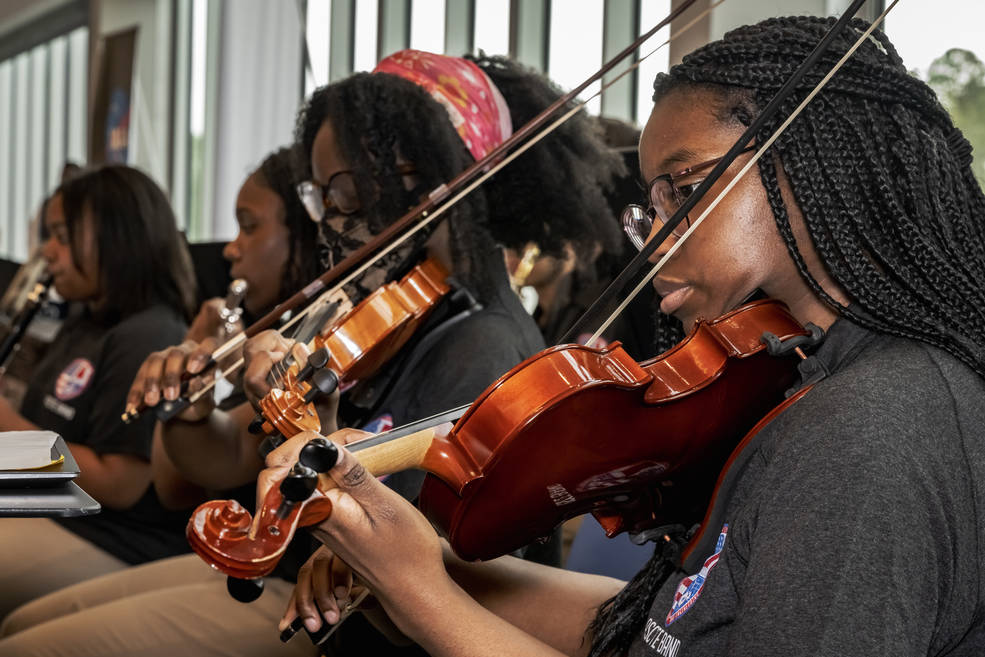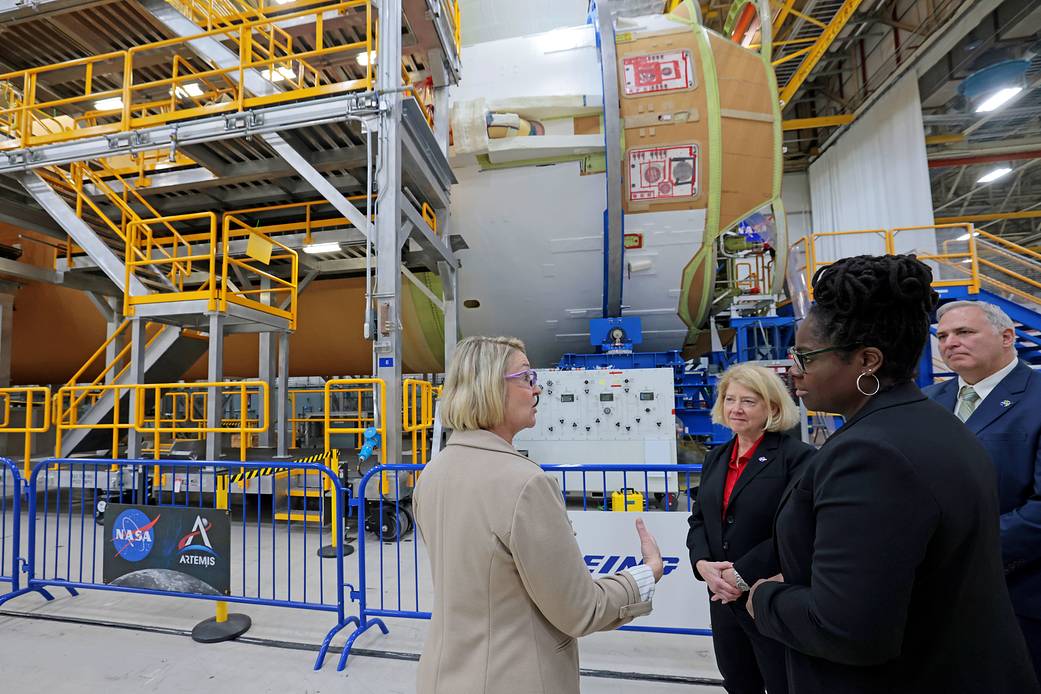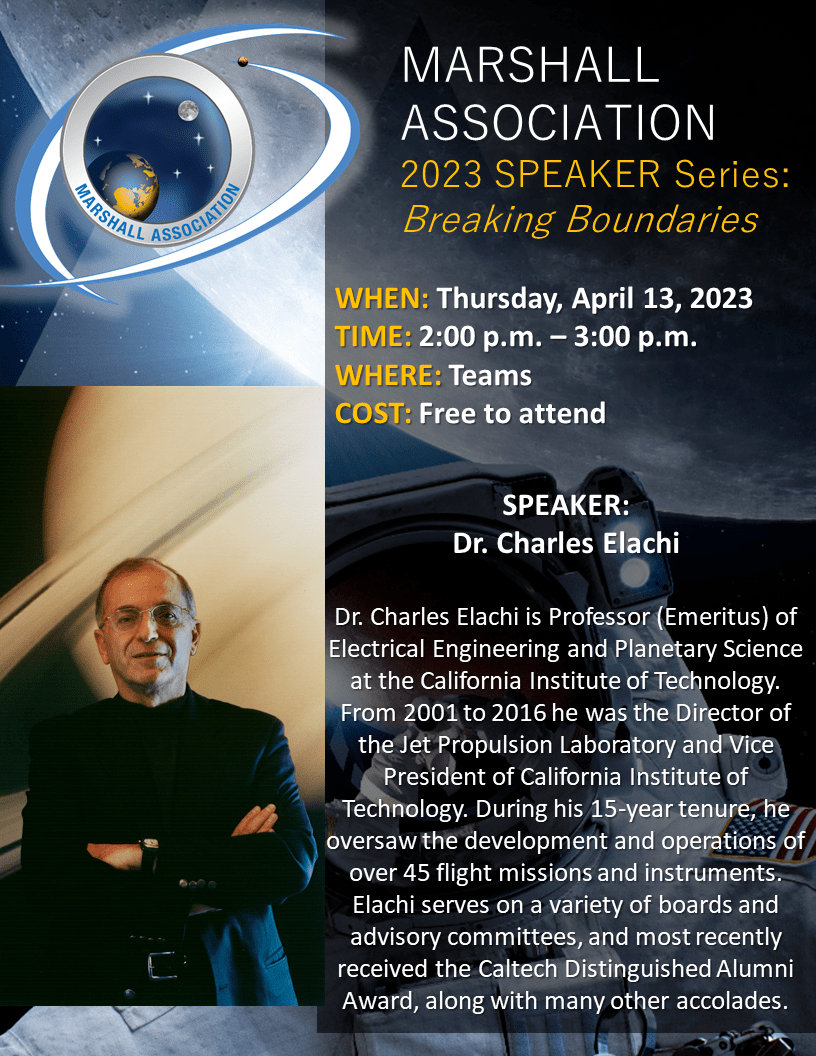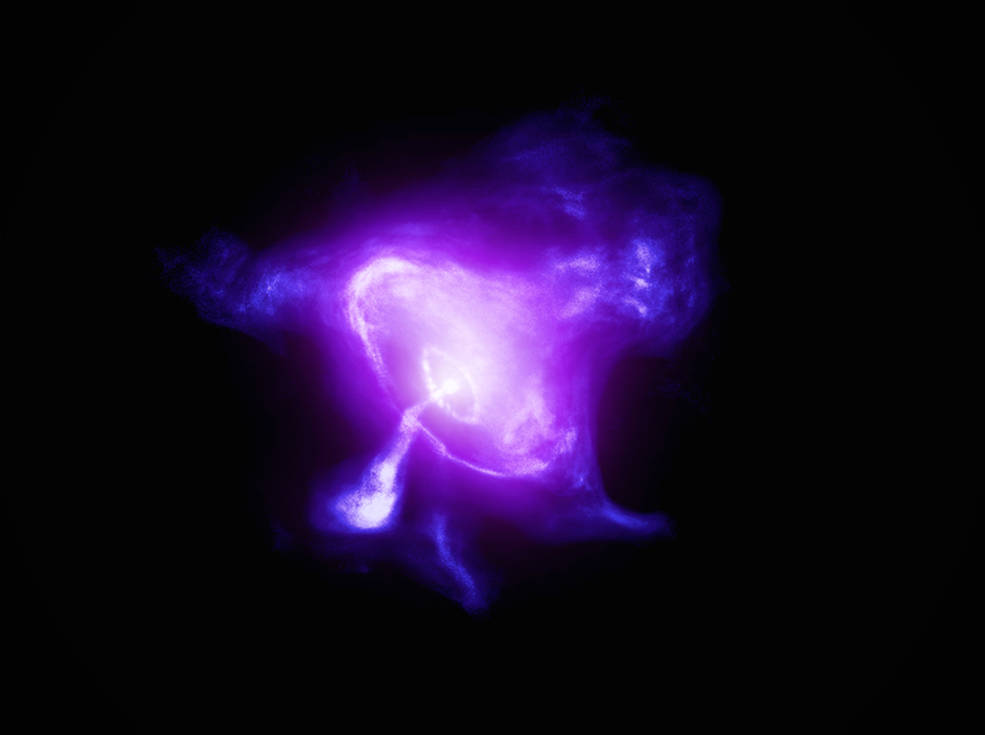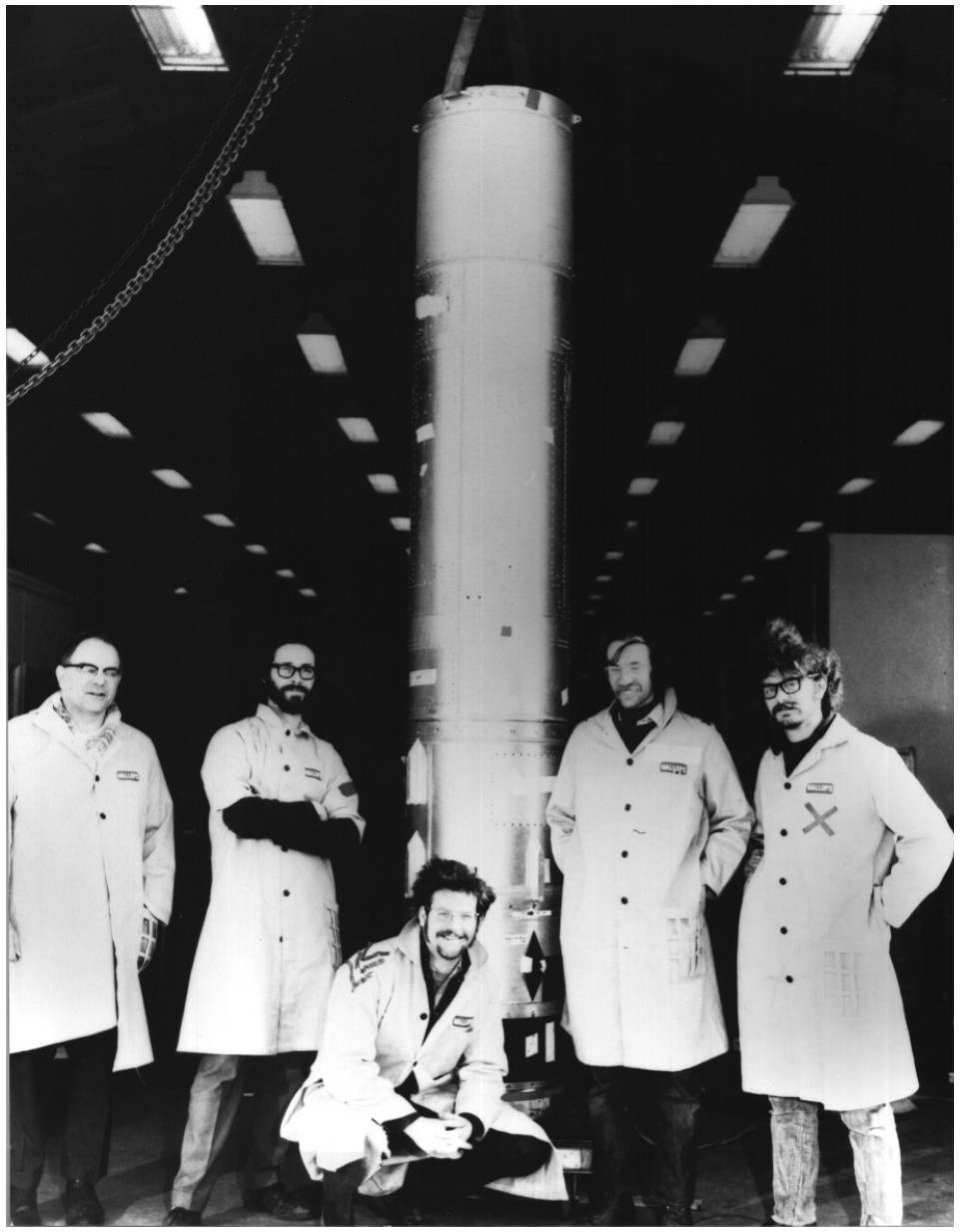The Marshall Star for April 12, 2023.
In This Week’s Star
- Rockets Return to North Alabama for NASA’s 2023 Student Launch
- Center to Celebrate Sustainability with Return to In-Person Earth Day Events
- FIRST Robotics Competition Returns to Rocket City
- Art, Artifacts Acquisition Continues for Planned Marshall Exploration Facility
- Stennis Conducts Fifth RS-25 Engine Test for Mega Rocket
- Marshall Signs Partnership Agreement with the Alabama School of Cyber Technology and Engineering
- NASA Deputy Administrator Melroy Views Artemis II Core Stage at Michoud
- Dr. Charles Elachi Guest for April 13 Marshall Association Speaker Series
- Historic Nebula Seen Like Never Before with NASA’s IXPE
Rockets Return to North Alabama for NASA’s 2023 Student Launch
Media and the public are invited to attend NASA’s 2023 Student Launch rocketry competition on April 15, from 9 a.m. to 2 p.m. CDT (or until the last rocket launches) at Bragg Farms, in Toney, minutes north of NASA’s Marshall Space Flight Center.
Nearly 800 students from universities, high schools, and middle schools will launch high-powered amateur rockets and scientific payloads to an altitude between 3,500 and 6,000 feet, before safely parachuting back to Earth.
NASA’s annual rocket competition will host more than 50 teams from 21 states and Puerto Rico, with more than 40 teams expected to launch in-person. For 2023, NASA is not requiring teams travel to Alabama, instead providing an alternative launch-from-home option. NASA’s streaming coverage will begin at 9 a.m. on NASA’s Marshall YouTube page and NASA’s Student Launch Facebook page.
NASA will also welcome the return of the Rocket Fair event April 14, 3-6 p.m. in downtown Huntsville. The Rocket Fair is a popular showcase allowing students to display their rockets while answering questions from the news media, NASA engineers, and members of the public.
Schedule of Events:
- Rocket Fair: April 14, 3-6 p.m., at Von Braun Center East Hall. This event is free and open to the media, public and children.
- Launch Day: April 15, 9 a.m. – 2 p.m., (or until last rocket launches) at Bragg Farms, in Toney. The event is free and open to the media, public and children. Please review NASA’s guest policy prior to attending for a list of prohibited items.
- Rain Date: April 16 is a tentative rain day in case of inclement weather. Launches will occur 9 a.m. to 2 p.m. (or until last rocket launches) at Bragg Farms.
NASA will announce the winning teams June 6 at 1 p.m. during a virtual awards ceremony after all teams’ flight data has been verified.
Student Launch is an eight-month-long design challenge providing relevant, cost-effective research and development of rocket propulsion systems. The annual competition is a part of the agency’s Artemis Student Challenges – a variety of activities providing students access to the knowledge and technology required to achieve the goals of the Artemis Program.
Marshall hosts the Student Launch challenge with management support provided by NASA’s Office of STEM Engagement – Southeast Region. Funding is provided, in part, by NASA’s Space Operations Mission Directorate and NASA’s Next Gen STEM project.
Center to Celebrate Sustainability with Return to In-Person Earth Day Events
By Jessica Barnett
There have been a lot of returns announced over the past few years, from a return to the Moon to the return of in-office working.
Later this month, NASA’s Marshall Space Flight Center will experience another return, this time in the form of an in-person celebration of our home planet and what’s being done to protect it.
Marshall’s Earth Day event will be 11 a.m. to 1 p.m. April 19 on the south lawn of Building 4221. After three years of virtual events, Marshall’s sustainability coordinator, Malene McElroy, said it’s exciting to finally gather again in person to explore what it means to “Invest in Our Planet,” the theme for this year’s event.
McElroy and a team of about a dozen other Marshall employees have been planning this event for several months, figuring out which activities will best showcase Marshall’s commitment to sustainable buildings and practices.
Here’s just some of what they have planned:
- Electric vehicle car show: Check out the new charging station and talk with EV owners about making the switch. You can even sign up here to show off your own EV.
- Group yoga class: Just bring your yoga mat and water to the south lawn. All experience levels welcome.
- Sustainable building tours: Sign up here for a 20-minute guided tour to see how 4221 was designed with sustainability in mind.
- Green Giveaways: Get a packet of pollinator flower seeds, an oak tree sapling, and even a keepsake made of biodegradable corn plastic.
Blue Origin, Trader Joe’s, Covanta, and TVA will also be onsite to highlight their work to better the environment.
“We’ve had all these ideas, and now we get to implement them, so the team is very excited,” McElroy said.
Marshall Director Jody Singer said she is also looking forward to the festivities.
“I am thrilled that we can celebrate Earth Day together this year, in person and on-site at Marshall,” Singer said. “This day truly represents the investment NASA is making in pursuing a better understanding of our solar system and our beloved home planet. Our dedicated teams at Marshall are innovating in ways that expand our understanding of climate science and advances weather prediction. Thanks to your efforts, we are saving and improving lives around the globe.”
Marshall employees can learn more about the Earth Day event here. All who attend will get the opportunity to take part in a post-event survey to help organizers as they begin planning next year’s event.
Barnett, a Media Fusion employee, supports Marshall’s Office of Strategic Analysis & Communications.
FIRST Robotics Competition Returns to Rocket City
Students from the Power Struck Girls Team 5965 – an all-girls FIRST Robotics team from the Academy of Our Lady high school in Marrero, Louisiana, and sponsored by NASA’s Stennis Space Center – make final engineering adjustments to their robot during the Rocket City Regional FIRST Robotics tournaments in Huntsville on April 7. More than 1,000 students from 14 states, Mexico, and Brazil competed to qualify for the 2023 FIRST Robotics Competition Championship event in Houston. FIRST Robotics is a national robotics competition for students in grades 9-12. NASA and its Robotics Alliance Project provide FIRST with grants and support to address the national shortage of students pursuing careers in science, technology, engineering, and math. The Rocket City Regional is supported by NASA’s Marshall Space Flight Center and NASA’s Office of STEM Engagement. (NASA/Joel Wallace)
Art, Artifacts Acquisition Continues for Planned Marshall Exploration Facility
By Rick Smith
As NASA’s Marshall Space Flight Center continues development of its new, state-of-the-art collaboration and innovation hub – the Marshall Exploration Facility – planners in the Facilities Engineering Office are working to adorn the new building with art and artifacts that honor Marshall’s pioneering role in science, discovery, and human spaceflight.
Marshall team members are invited to contribute artifacts and art for consideration, including drawings, models, prototypes, materials samples, and hardware components used to support development of rockets, and other spaceflight hardware or test articles.
Artifacts being considered for display in the new building include the Marshall Center dedication letter signed by former President Dwight Eisenhower; a U.S. flag that flew on the space shuttle; and a full-scale Fastrac engine – the turbopump-fed, liquid rocket engine initially developed at Marshall in the late 1990s for the X-34 Reusable Launch Vehicle Program.
Tracie Tarel, an architect in Marshall’s Facilities Engineering Office, said the team is curating a variety of vintage artwork for the walls – including Apollo-era sketches and paintings by such notable artists as Russ Arasmith, Frank Kulczak, and Renato Moncini.
The team also is assessing how best to display the commissioned portraits of 14 Marshall directors which previously hung in Morris Auditorium in Building 4200. Granite slabs, wooden wall elements, and other mementos of that storied hall also were preserved and will be integrated where appropriate.
“We don’t want to overstuff the building. Everything needs to work together in harmony,” Tarel said. “We’ll partner with the building designers to use what artifacts and memorabilia we’ve got in an integrated, aesthetically pleasing way.”
Milestones on view won’t be limited to Marshall’s past history, said Marshall facilities engineer Angie Bell. The facility also will celebrate the path ahead, as NASA enters a new era of exploration. A scale model of the Space Launch System – the flagship rocket of NASA’s new Artemis Program – will figure prominently, alongside models of the Mars Ascent Vehicle, future Moon and Mars landers, and other current and upcoming solar system missions.
Items submitted for consideration may not find a home in the new facility – but other options may present themselves. “With everything we look at, we’ll return it when we’re done or find it a good home,” Tarel said.
To submit items for consideration, email information about each piece to Tarel and Bell. Include digital photographs where possible. Items of any size will be considered, and do not need to be in mint condition. Submissions will be accepted through June 1.
Smith, a Manufacturing Technical Solutions employee, supports Marshall’s Office of Strategic Analysis & Communications.
Stennis Conducts Fifth RS-25 Engine Test for Mega Rocket
NASA conducted a long duration hot fire of an RS-25 certification engine for future Space Launch System (SLS) rockets on the Fred Haise Test Stand (formerly A-1 Test Stand) at NASA’s Stennis Space Center April 5. The test was the fifth in a planned 12-part test series that began earlier this year to certify production of the newly redesigned RS-25 engines by lead contractor Aerojet Rocketdyne. The test had a planned duration of 500 seconds, the length of time the engines must fire during an actual flight, with a maximum 113% power level, more than the up to 111% power level needed to help power SLS at launch. (NASA)
Marshall Signs Partnership Agreement with the Alabama School of Cyber Technology and Engineering
NASA Marshall Space Flight Center Deputy Director Joseph Pelfrey, front right, speaks during an April 4 signing event at the Alabama School of Cyber Technology and Engineering (ASCTE) in Huntsville. Marshall signed a memorandum of understanding with the school to embark upon a mutually beneficial partnership. The center will provide speakers, materials, tours of the facility, mentorship, and other support to the school. ASCTE is the nation’s only high school focused on the integration of cyber technology and engineering into all academic disciplines. ASCTE is a public, commuter, and residential magnet high school serving students throughout Alabama. Tuition and housing are free. “NASA – and Marshall – are successful because of the strong partnerships and cooperation we have with international, commercial, and academic partners across the nation and our state,” Pelfrey said. “Through strategic academic partnerships like this one with the Alabama School of Cyber Technology and Engineering, Marshall is helping to ensure the next generation of explorers, engineers, scientists, and technicians have the foundation they need to be successful. Marshall is invested in the Artemis Generation and dedicated to helping these students succeed. Programs with schools like ASCTE and events like Human Exploration Rover Challenge and Student Launch encourage students to put their STEM skills to use and provide hands-on technology and engineering experience for young people.” (NASA/Mick Speer)
Students with the ASCTE band perform during the signing event with Marshall. (NASA/Mick Speer)
NASA Deputy Administrator Melroy Views Artemis II Core Stage at Michoud
NASA Deputy Administrator Pam Melroy, middle, and Dr. Quincy K. Brown, front right, senior policy advisor in the White House Office of Science and Technology Policy, are shown the core stage of NASA’s Space Launch System (SLS) rocket by Jennifer Boland-Masterson, left, director of manufacturing and site leader at NASA’s Michoud Assembly Facility for Boeing, during a March 31 visit to Michoud. They are accompanied by Michoud Facility Director Lonnie Dutreix, back right. The 212-foot-tall core stage and its four RS-25 engines will help power NASA’s Artemis II flight test, the first crewed Artemis mission that will send four astronauts around the Moon and return them home to test the spacecraft in deep space ahead of lunar surface missions. Teams at Michoud recently integrated the last of the five major core stage structures and unboxed the four RS-25 engines. NASA and Boeing, the core stage lead contractor, along with Aerojet Rocketdyne, the RS-25 engine lead contractor, are preparing to install the engines to the base of the rocket’s core stage. The core stage and its RS-25 engines produce more than 2 million pounds of thrust at launch. NASA is working to land the first woman and first person of color on the Moon under Artemis. SLS is part of NASA’s backbone for deep space exploration, along with Orion and the Gateway in orbit around the Moon. SLS is the only rocket that can send Orion, astronauts, and supplies to the Moon in a single mission. (NASA/Michael DeMocker)
Dr. Charles Elachi Guest for April 13 Marshall Association Speaker Series
Dr. Charles Elachi, professor emeritus of electrical engineering and planetary science at the California Institute of Technology, will be the guest speaker for the Marshall Association Speaker Series on April 13. The meeting topic follows this year’s theme of Breaking Boundaries, and is from 2 to 3 p.m. The virtual event can be heard via Teams link here. The event also is in recognition of Arab American Heritage Month. Elachi, a Lebanon native, was the director of NASA’s Jet Propulsion Laboratory and vice president of the California Institute of Technology from 2001 to 2016. During his 15-year tenure, he oversaw the development and operations of over 45 flight missions and instruments. Elachi has been a principal investigator on several NASA-sponsored studies and flight projects, including the Shuttle Imaging Radar series (science team leader), the Magellan Imaging Radar (team member), the Cassini Titan Radar (team leader), and co-investigator on the Europa Sounding Radar. He serves on a variety of boards and advisory committees, and most recently received the Caltech Distinguished Alumni Award, along with many other accolades. For more information on the Marshall Association and how to join, visit their page on Inside Marshall. (NASA)
Historic Nebula Seen Like Never Before with NASA’s IXPE
On Feb. 22, 1971, a sounding rocket lifted off from Wallops Island, Virginia, with specialized sensors aimed at the Crab Nebula, a bright cosmic object 6,500 light-years away. In those days, before recovering physical tapes from the experiment, scientists first received scientific data on a strip chart recorder, a device that printed signals on paper. Astronomer Martin Weisskopf and his colleagues began their analysis on launch day by measuring the distance between signals using a ruler and pencil.
“What makes science so beautiful and exciting is that for those few moments, you’re seeing something that no one has ever seen before,” said Weisskopf, now an emeritus astronomer at NASA’s Marshall Space Flight Center.
Decades later, Weisskopf proposed the development of an Earth-orbiting satellite with powerful instruments that could gather much more detailed measurements of the same kind about the Crab Nebula and other mysterious cosmic objects. That satellite became NASA’s Imaging X-ray Polarimetry Explorer (IXPE), which launched on December 9, 2021.
Now, more than 50 years after the sounding rocket experiment, scientists have used IXPE to create a detailed, nuanced map of the Crab Nebula’s magnetic field, revealing more of its inner workings than ever before. The new results, published in the journal Nature Astronomy (preprint available), help resolve longstanding mysteries about the well-studied Crab Nebula and open new questions for future study.
IXPE data show that the Crab Nebula’s magnetic field resembles that of the Vela Pulsar Wind Nebula, which is also donut-shaped. But at the Crab, scientists were surprised that areas of magnetic field turbulence were more patchy and asymmetrical than expected.
“This is a clear indication that even the more complex models developed in the past, with the use of advanced numerical techniques, do not fully capture the complexity of this object,” said Niccolò Bucciantini, lead author of the study and astronomer at the INAF Arcetri Observatory in Florence, Italy.
A favorite object of study among astronomers, the Crab Nebula resulted from a supernova documented in the year 1054. The explosion left behind a dense object called the Crab Pulsar, about the diameter of Huntsville, or the length of Manhattan, but with as much mass as about two Suns. The chaotic mess of gases, shock waves, magnetic fields and high-energy light and particles coming from the rotating pulsar is collectively called a “pulsar wind nebula.” These extreme conditions make for a bizarre environment that is not yet thoroughly understood.
Weisskopf and colleagues were hoping to understand this extreme environment in a new way by measuring the polarization of X-rays from the Crab Nebula, which shines brightly in X-rays. X-ray polarization gives scientists clues to the direction where the magnetic field points in different parts of a cosmic object, as well as how well ordered the magnetic field is. The magnetic field’s geometry and turbulence determines how particles get catapulted toward the speed of light.
In the five minutes that the 1971 sounding rocket experiment spent above Earth’s atmosphere, it produced the world’s first X-ray polarization measurements.
Scientists followed up with a satellite called OSO-8 in 1975, which also measured the X-ray polarization of the Crab Nebula. The rocket and the satellite produced generally the same result: That the Crab Nebula has an average polarization of about 20%.
As project scientist of NASA’s Chandra X-Ray Observatory, which launched in 1999, Weisskopf continued his exploration of the Crab Nebula in new ways. With Chandra, “we took beautiful images of the nebula and pulsar, and we could see the jets and the various structures,” he said. Chandra’s X-ray imaging revealed wisp-like structures that move in the nebula, and helped scientists to further understand the relationship between the pulsar’s energy and X-ray emissions.
Nearly every recent large telescope has pointed to the Crab Nebula to better understand this mysterious supernova remnant. But only IXPE can study X-rays from Crab in terms of polarization, a measure of the organization of electromagnetic fields.
“The Crab is one of the most-studied high-energy astrophysical objects in the sky. So it is extremely exciting that we could learn something new about this system by looking through IXPE’s ‘polarized lenses,’” said Michela Negro, a research scientist at NASA Goddard Space Flight Center, affiliated with the University of Maryland, Baltimore, and a co-author of the study.
Across the entire nebula, IXPE found about the same average polarization as Weisskopf and colleagues did in the 1970s. But with more sophisticated instruments, IXPE was able to refine the angle of polarization and examine the differences in polarization across the entire object. Scientists see areas of much polarization in the outer regions of the nebula, light-years away from the pulsar, where polarization is lower.
This enabled scientists to investigate not just X-rays from the Crab Nebula but also those coming from the pulsar itself, or the sphere of magnetic fields around it. The findings suggest that those X-rays originate in the outer magnetic field region, called the “wind” region, although exactly where and how is still unknown. Within the magnetic field, shocks generated by the pulsar’s “wind” are propelling particles close to the speed of light.
“I’m very proud of everybody associated with IXPE,” said Weisskopf, who was the mission’s first principal investigator. “Everybody has worked so hard, and it works as advertised.” Reflecting on his work on the 1971 experiment that laid the groundwork for the new results, Weisskopf says, “It’s like somebody said to me, ‘Martin, you did good.’”
Part of NASA’s Small Explorer mission series, IXPE launched on a Falcon 9 rocket from NASA’s Kennedy Space Center in December 2021. It now orbits 370 miles, or roughly 595 kilometers, above Earth’s equator. The mission is a partnership between NASA and the Italian Space Agency, with partners and science collaborators in 13 countries. Ball Aerospace, headquartered in Broomfield, Colorado, manages spacecraft operations.


























